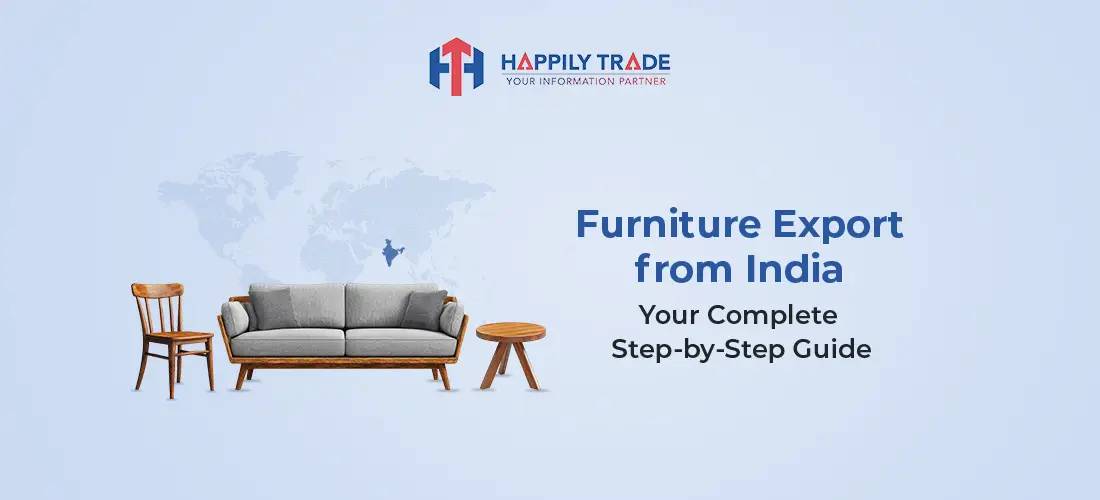Furniture Export from India: A Step-by-Step Guide
- Log in to post comments
India, with its rich heritage of craftsmanship and diverse raw materials, is rapidly emerging as a significant player in the global furniture market. In the financial year 2022–2023, India's furniture export revenue reached $5 billion, reflecting its growing dominance in international trade. Moreover, the Indian furniture market is projected to expand at a CAGR of 6.04% from 2025 to 2029, making it a promising sector for exporters. If you're looking to tap into this lucrative opportunity, understanding the intricacies of furniture export from India is crucial. This comprehensive guide will walk you through the essential steps to successfully export furniture from India, ensuring you navigate the process smoothly and efficiently.
Overview of the Indian Furniture Industry
The Indian furniture industry is diverse, comprising small-scale artisans, family-run businesses, and emerging large enterprises. A large portion remains fragmented, with many companies run by traditional craftsmen specializing in hand-carved wooden furniture, wickerwork, and intricate inlay designs. However, the industry is evolving with the entry of major domestic brands like Godrej and global corporations recognizing India's potential as a manufacturing hub.
India ranks as the fifth-largest producer and exporter of furniture in the Asia-Pacific region, reinforcing its role in global trade. With government initiatives like "Make in India" and the rise of e-commerce, furniture export from India is seeing significant growth. The shift toward organized manufacturing, sustainable production, and export-driven strategies presents lucrative opportunities for businesses looking to expand in domestic and international markets.
Understanding the Market for Furniture Export from India
Before diving into the export process, it's crucial to understand the market dynamics and demand-supply patterns. India has established itself as a key player in the global furniture trade, primarily exporting solid wood furniture known for its durability, intricate craftsmanship, and eco-friendly materials. At the same time, the country imports modular board furniture, upholstered furniture, panel furniture, and case goods to meet domestic and commercial needs. This balance between exports and imports highlights the opportunities and challenges in the furniture export from India sector.
By identifying niche areas where Indian furniture excels—such as handcrafted wooden pieces and sustainable bamboo furniture—exporters can gain a competitive advantage in international markets. Additionally, understanding emerging trends like customized furniture solutions, ergonomic designs, and multi-functional furniture can help exporters cater to evolving consumer preferences worldwide.
Identifying Target Markets
Thorough research on potential export destinations is essential for building a profitable furniture export from India business. Countries in Europe, North America, and the Middle East have consistently shown high demand for Indian furniture due to its unique designs and quality craftsmanship. Understanding each region's preferences, pricing expectations, and regulatory requirements is crucial for formulating a successful export strategy.
Additionally, analyzing competitor activity, customer trends, and trade regulations in these markets will help exporters position their products effectively. Establishing a strong presence in the right markets through strategic partnerships, trade shows, and online marketplaces can lead to long-term growth and increased profitability in the furniture export industry.
Key HS Codes for Furniture Export
Understanding Harmonized System (HS) codes is crucial for smooth documentation and compliance with import-export regulations. The primary HS code for furniture is 9403, covering "Other furniture and parts thereof." Within this broad category, the following specific codes are essential for Indian furniture exporters:
- 94036000 - Other wooden furniture (a key category for Indian exporters).
- 940330 - Wooden furniture designed for office use.
- 940350 - Wooden furniture used in bedrooms.
- 940310 - Metal furniture designed for office use.
- 94038200 - Furniture made from bamboo.
- 94038300 - Furniture made from rattan.
Using the correct HS code ensures proper documentation, facilitates smooth customs clearance, and helps determine applicable import-export duties for different markets.
Steps to Export Furniture from India
1. Business Registration and Compliance
Registering your business is the first step in legally starting furniture export from India. You must obtain:
- Import-Export Code (IEC) from the Directorate General of Foreign Trade (DGFT) is mandatory for all exporters.
- GST Registration for taxation purposes and compliance with local laws.
- Registration with the Export Promotion Council for Handicrafts (EPCH) if exporting handmade or wooden furniture to avail government incentives.
- Compliance with the Bureau of Indian Standards (BIS) for quality assurance and meeting global standards.
2. Selecting the Right Furniture for Export
Indian furniture is diverse, and selecting the right category is essential. Some popular export categories include:
- Handcrafted wooden furniture (Sheesham, teak, mango wood) is known for durability and unique craftsmanship and is often sought after for traditional and luxury interiors.
- Bamboo and Rattan Furniture (eco-friendly and lightweight)—Preferred in sustainable and minimalistic markets, bamboo and rattan furniture are increasingly popular in Europe and North America.
- Metal and Industrial-Style Furniture (Popular in European markets) – Used in urban and contemporary interior designs, offering a blend of durability and aesthetic appeal.
- Modular and Contemporary Furniture (High demand in urban areas) – Suitable for modern homes and offices, with a growing market in coworking spaces and smart homes.
3. Pricing and Cost Analysis
Setting competitive prices is essential for profitable furniture export from India. Consider factors such as:
- Raw Material Costs (Wood, metal, upholstery, labor) – Prices may fluctuate based on availability and demand, affecting profit margins.
- Manufacturing Costs (Carving, assembling, finishing) – Includes labor wages, automation investments, and production overheads.
- Packaging and Freight Costs (Export-grade packing, container charges): Ensure furniture is safely transported to prevent damages and reduce returns.
- Duties and Taxes (Customs duty, GST, import tariffs in destination countries) – Vary by country and affect pricing strategies, making cost analysis crucial for competitive pricing.
4. Quality Standards and Certifications
Exporting furniture requires adherence to international quality standards. Essential certifications include:
- ISO 9001: Quality Management System Certification for improved processes and credibility in global markets.
- FSC (Forest Stewardship Council): Ensures wood is sourced sustainably, a key requirement for eco-conscious buyers.
- CE Marking: Necessary for compliance in European countries, ensuring safety and durability standards are met.
- ANSI/BIFMA Certification: Required for exporting office furniture to the USA, verifying performance and safety criteria.
5. Choosing the Right Shipping Method
Shipping furniture internationally requires careful planning. Exporters can choose from:
- Full Container Load (FCL): Ideal for bulk orders, reducing per-unit shipping costs and improving efficiency.
- Less than Container Load (LCL): Cost-effective for small and medium shipments, offering flexibility in order fulfillment.
- Air Freight: This is a faster option for premium and urgent shipments but comes at a higher cost and is typically used for lightweight or high-value items.
Proper packaging, including bubble wrap, corrugated sheets, and waterproof coverings, ensures furniture arrives perfectly. Working with trusted freight forwarders and customs brokers can streamline logistics and minimize delays.
Challenges in Furniture Export from India
While furniture export from India presents great opportunities, exporters must navigate challenges such as:
- Stringent quality control standards in Western markets – Requires compliance with international safety norms.
- High logistics and transportation costs - Bulky furniture results in increased freight expenses.
- Fluctuating raw material prices affect profitability due to changing costs for wood and metal.
- Complex international trade regulations - Each country has unique import policies and tax structures.
Overcoming these challenges through efficient supply chain management, government incentives, and thorough market research can enhance profitability.
Boost Your Furniture Export from India with Happily Trade EXIM
Expanding your furniture export from India? Gain a competitive edge with Happily Trade EXIM, your trusted partner for accurate and real-time import export data. We provide comprehensive trade insights, helping exporters identify high-demand markets, track competitor shipments, and optimize pricing strategies.
With our vast database covering global trade transactions, you can access essential details like HS codes, buyer information, and shipping trends. Our data-driven approach ensures you make informed business decisions, reducing risks and maximizing profitability.
Stay ahead in the dynamic global market with Happily Trade EXIM. Explore new opportunities, streamline your export process, and achieve success in international trade. Start leveraging import export data today!








